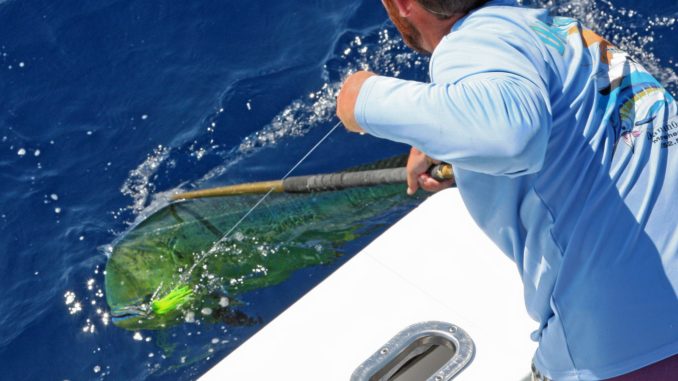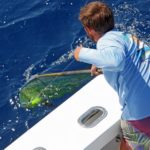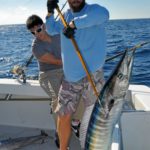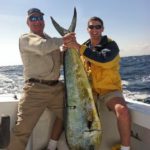
Check bottom structure for wahoo, surface structure for dolphin as fish move toward shoreline.
The deep, muffled throbbing of the twin 600-horsepower CAT diesels and the gentle rocking inside the cabin of the Dancin’ Outlaw III as it sped across a calm sea finally put to sleep six anglers.
They had arrived at 5:15 a.m. at the Morehead City Waterfront boat slip where Capt. Thomas Wood moored his 56-foot sportsfisherman.
Andy Lee, Han Pyun, Nam Kang, Josh Kim, David Ko and Han Suk — born in South Korean and now living in Charlotte — were going deep-sea fishing, five for the first time.
They’d excitedly taken photos before they boarded the boat and while Wood guided his vessel through dark Beaufort Inlet. By the time they reached the Knuckle Buoy, most of the once-excited anglers were nodding; 30 minutes later all were asleep.
A Morehead City offshore captain for 20 years, Wood was gratified and accustomed they’d chosen him, mate Jay Rivenbark and the Dancin’ Outlaw III.
“I’ve had people from all over the United States and other countries on my boat, but that’s common for captains,” said Wood, 53. “These guys seem like a nice bunch.”
They were excited about fishing the deep blue with Wood, who has the reputation along the waterfront as a good person and fine captain and angler.
“I guess I ought to know about fishing by now,” he said with self-depreciation. “I’ve been taking people out for 20 years.”
When he was starting as a captain, others had dispensed information when Wood asked, so he always returns the favor.
“I don’t have any qualms about sharing what I know about this kind of fishing with anyone because it’s what I love,” Wood said. “We want anglers to feel free to ask us anything. There aren’t any dumb questions, only dumb answers, and I try not to give any of those.
“If people want to know about bait-rigging, areas to fish and what to look for in the water, we’ll be happy to tell them what we know. If people are more interested in the catching part, we’ll tell ’em what we’re rigging and how we’re using equipment.”
Only one of Wood’s clients had offshore fishing experience.
“I did some salmon fishing when I lived in Seattle,” said Kang, a UNC-Greensboro software manager, “but we were in a much smaller boat. It was more like bottom-fishing. I caught Dungeness crabs later in Florida, and I caught some red snappers. I love it, but I haven’t been able to do much (fishing) in North Carolina. That’s why I’m happy to be here with my friends to go on this boat.”
The 56-foot Dancin’ Outlaw III was certainly a fine choice. It can reach Wood’s favorite fishing spots south of the Big Rock in roughly 2 1/2 hours, depending upon sea conditions. But Wood, a native of West Virginia, is happier when June arrives because that’s when dolphin and wahoo follow baitfish that move closer to shore. That means the trip to prime fishing territory may require two hours or less and result in a lighter fuel bill.
“In May, I still have to go to the Gulf Stream for (dolphin) and wahoos,” Wood said. “But dolphins move inshore when there’s warmer water 30 to 40 miles off the beach. And wahoos also will be closer then.”
Wood knows and has marked with electronics many bottom features that hold wahoo. He also charts currents and water temperatures to find the most beneficial conditions for dolphins.
“It’s a matter of looking for bottom structure, if I’m targeting wahoo, and surface conditions if I’m going for dolphin,” he said.
But he doesn’t have predetermined spots or routes to fish. That’s a matter of daily and nightly preparation.
“I study weather conditions, water temperature and satellite shots,” Wood said. “The captains on the waterfront also talk to each other. We’re competitive because we want clients to have great fishing experiences, but we also help each other. I don’t guarantee any group we’ll catch fish, but I do guarantee we’ll work as hard as we can to find fish — we just can’t make ’em bite.”
During June, wahoo and dolphin often swim in the same general areas, where the water temperature is 68 degrees or higher. But they may concentrate at different places or move across various sections of ocean, so Wood may rig for wahoo while he’s trolling toward dolphin areas and vice versa.
“I’m looking at the bottom to see if it’s holding baitfish and wahoo,” Wood said. “I’ll be looking for rocks and wrecks. I’m talking about rocks the size of trucks, but it doesn’t take a lot (of structure) to hold bottomfish that will hold gamefish above them.
“Sometimes I’ll also look for breaks, which are places where the temperature changes, and I’ll also look for the direction the current is running.”
To find conditions that may concentrate dolphins, Wood does just the opposite — he checks out the surface.
“For dolphins, I’m looking at top conditions,” he said. “I’m especially looking for Sargassum (sea weed) floating on tide lines.”
Dolphins like sea weeds because baitfish hide in the vegetation. The floating, green clumps offer the main available cover in the open ocean, although dolphin will suspend under other junk such as boards, wooden pallets or even cardboard.
Captains who target dolphins search sea weed concentrated by tide lines and troll parallel to the floating plants. If they don’t get bites on one side of a weedline, they’ll cut through and troll down the other side. Anglers often see dolphins dart from underneath weed lines to grab trolled baits or bait chunks cast at them after one dolphin is hooked and is kept in the water, behind the boat.
The presence of flying fish also indicates dolphins. Their skips across the surface often mean baitfish schools are near, and dolphins will be around baitfish. Additionally, flocks of flying birds or a solitary frigate bird may indicate dolphins. Hovering or diving birds often mean baitfish are being chased at the surface by false albacore or bonito. Dolphins often hang out near this commotion because of baitfish.
“I troll medium-size ballyhoo for dolphin and wahoo,” Wood said. “If I think a blue marlin might be around, I’ll set up heavier tackle and pull a horse ballyhoo.”
The only differences in Wood’s terminal tackle for dolphins and wahoos are the leaders. Because wahoos have razor-sharp teeth, Rivenbark ties a blue or blue-and-white Sea Witch skirt in front of a medium-size ballyhoo fitted with a 5-foot length of 50-pound-test stainless-steel wire leader wrapped into a 7/0 hook. The wire prevents a wahoo’s teeth from slicing through the leader if it attacks the bait.
Because dolphins don’t have sharp teeth, 12 feet of 80- to 100-pound fluorocarbon leader will work.
Wood may troll one wahoo rig from an outrigger and one from a bridge pole, but sometimes he prefers one wahoo rod with the other rods pulling dolphin baits.
His equipment includes top-of the-line Penn International Big Game rods and Shimano Tiagra or TLD reels in 50, 80 and 130 sizes, the latter for blue marlin.
If dolphin or wahoo action is slow, Wood may stop at a ledge, rocks or wrecks where bottomfish live.
“I try to be flexible and put anglers on fish, but if there’s one species that they want, my belief is the customer is always right,” Wood said. “If they want dolphin, then we’ll try to find them some dolphin. The good thing about June is I also can have a rod (set up) for wahoos, and if one shows up, we’ll have a chance to catch him, too.”
Most of his wahoo baits run farther behind the boat’s stern than his dolphin baits. That he uses wire leaders on the wahoo rigs isn’t important because trolling speed is 12 to 13 knots, fast enough to make a ballyhoo skip across the surface with the leader invisible to the sharp-eyed fish.
Wood has some of the top tournament credentials among Morehead City’s offshore captains, having won more than $750,000 during billfish tournaments.
“But my main interest isn’t fishing in tournaments, although that’s a lot of fun,” he said. “It’s helping people, particularly young people, create lasting memories when they go fishing. And June is definitely one of the best months for making memories.”
DESTINATION INFORMATION
HOW TO GET THERE — Follow US 70 east from Raleigh to Morehead City or US 17 north from Wilmington, then NC 24 east to Morehead City. From northeastern North Carolina, follow US 17 south to New Bern, then US 70 to Morehead City.
WHEN TO GO — May to September.
BEST TECHNIQUES — Anglers may want to sit in a fighting chair or use stand-up equipment for dolphin and wahoo. Shimano Tiagra rod and reel combos in 50 to 80 sizes work well. Wahoo terminal tackle needs to include 5 feet of wire leader to avoid cut-offs, while 80- to 100-pound fluorocarbon leaders work well for dolphin. Trollers may catch dolphin and wahoo with Sea Witch skirts in front of medium-size ballyhoo.
FISHING INFO/GUIDES — Thomas Wood, Dancin’ Outlaw Charters, 252-504-2342, www.dancinoutlaw.net. See also Guides and Charters in Classifieds.
ACCOMMODATIONS — Crystal Coast Visitors Bureau, 800-SUNNY-NC, www.crystalcoastnc.org.
MAPS — Capt. Segull’s Nautical Charts, 888-473-4855, www.captainsegullcharts.com; Sealake Fishing Guides, 800-411-0185, www.thegoodspots.com; Maps Unique, 910-458-9923, www.mapsunique.com; Grease Chart, 800-326-3567, www.greasechart.com.







Be the first to comment